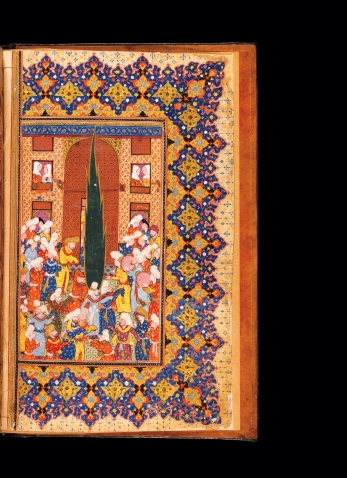During the Mongol invasion of Persia in the 13th century, the poet Sa‘di traveled across the land witnessing the struggles of his countrymen. He wrote stories about the triumph of the wise and virtuous over the foolish and vindictive. He also retold popular stories of the Prophet Muhammad. When he was old, Sa‘di returned as an honored poet to his home village of Shiraz, in what is now southern Iran. His proverbs are still quoted today.
A superb, 670-page illuminated manuscript, containing the complete collected works (known as a Kulliyat) of this renowned poet, is part of Clapp Library’s Special Collections. The book was completed in 1596, likely in a workshop in Shiraz, whose artists and calligraphers were at this time reaching “a pinnacle in the production of lavishly illustrated versions of Sa‘di’s writings,” says Lamia Balafrej, assistant professor of art.
The book’s pages reveal exquisite small paintings in vivid colors; delicately drawn borders of flowers, twining vines, and cavorting animals; and a flowing calligraphic script known as nasta‘liq, which mimics the movement of lyrical poetry.
While a man says not a word
His fault and virtue are concealed.
Think not that every desert is empty.
Possibly it may contain a sleeping tiger.
—Translated from The Manner of Kings by Sa‘di, 13th-century Persian poet
Shown in the paintings are men in turbans riding horses or fantastic beasts, celebrating festivals, dancing, conversing, arguing, and eating. Among these are the mystic Sufi dervishes. In some of the paintings, a few women look on from a distance. In another, the Prophet is depicted riding up to heaven surrounded by angels. Balafrej says that while figurative imagery is generally not found inside mosques and the Qur’an was never illustrated, representations of humans, animals, and even the Prophet are common in books of this kind, which are not considered religious texts.
Books were treasured in the Islamic world not only as emblems of knowledge and wealth, but also for their portability. The Kulliyat of Sa‘di was probably made for a rich patron in Shiraz, says Balafrej, or possibly it was intended for export to the Ottoman court in Istanbul, where it could have been a gift used to seal a friendship or a business deal.
Centuries later, the book still inspires awe. Balafrej brings her students in the Islamic art survey course to pore over its pages. “They are amazed by the quantity and quality of the decorations,” she says. “Every page has something to look at, every margin. It’s a book that renders very well the word ‘illumination.’”








We ask that those who engage in Wellesley magazine's online community act with honesty, integrity, and respect. (Remember the honor code, alums?) We reserve the right to remove comments by impersonators or comments that are not civil and relevant to the subject at hand. By posting here, you are permitting Wellesley magazine to edit and republish your comment in all media. Please remember that all posts are public.